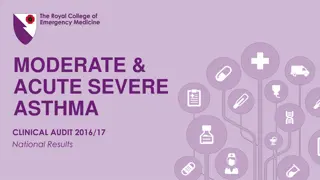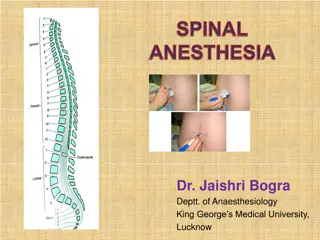Insights on Patient Experiences of Anesthesia Awareness: NAP5 National Audit Project
This study from the 5th National Audit Project (NAP5) delves into patient experiences of Anesthesia Awareness with General Anesthesia (AAGA). It highlights that not all AAGA instances are remembered, even with light sedation. The project explores the factors influencing memory during anesthesia, such as auditory perceptions, feelings of helplessness and fear, and the creation of false memories. The research also addresses memory formation, recall delays, and the trustworthiness of patient reports regarding AAGA.
Download Presentation

Please find below an Image/Link to download the presentation.
The content on the website is provided AS IS for your information and personal use only. It may not be sold, licensed, or shared on other websites without obtaining consent from the author.If you encounter any issues during the download, it is possible that the publisher has removed the file from their server.
You are allowed to download the files provided on this website for personal or commercial use, subject to the condition that they are used lawfully. All files are the property of their respective owners.
The content on the website is provided AS IS for your information and personal use only. It may not be sold, licensed, or shared on other websites without obtaining consent from the author.
E N D
Presentation Transcript
NAP5 The 5th National Audit Project Patient experiences of AAGA Jackie Andrade Cognition Institute Plymouth University NAP5 NAP5 The 5th National Audit Project The 5th National Audit Project
NAP5 The 5th National Audit Project A study of patient reports Not all AAGA is remembered Even light sedation prevents recall on recovery Patients can be responsive during GA but remember nothing on recovery 100 80 % patients From Russell (1993): 72% IFT response, 0% postoperative recall 60 40 20 0 NAP5 The 5th National Audit Project
NAP5 The 5th National Audit Project Memory for AAGA 1-2 per 1000 1 in 3 reported > 1 week Wide variation in patients experiences of AAGA Auditory perceptions are common, as are feelings of helplessness and fear Previous studies have tried to elicit recall by repeatedly interviewing patients using the modified Brice procedure NAP5 The 5th National Audit Project
NAP5 The 5th National Audit Project How memory works Why so few? Why the delay? Can we trust them? NAP5 The 5th National Audit Project
NAP5 The 5th National Audit Project Why so few memories? Memories are reconstructed not replayed Need to understand the experience: Bransford & Johnson (1972) Need to know source of the memory (otherwise imagination or dream) Need to have unique retrieval cues NAP5 The 5th National Audit Project
NAP5 The 5th National Audit Project Why is recall delayed? Memories are over-written by more recent memories Shared retrieval cues AAGA patient regains consciousness at least twice NAP5 The 5th National Audit Project
NAP5 The 5th National Audit Project Can we trust reports of AAGA? False memories created by inserting erroneous information Ceci: Tell me about what happened when you went to hospital Tell me about the time you heard people talking during your operation Reports of dreaming are different: pleasant content, unrelated to DoA, reported soon on emergence NAP5 The 5th National Audit Project
NAP5 The 5th National Audit Project NAP5 results 141 certain/probable or possible cases (1:20,000 cf 1:600 with Brice) 43% reported to another anaesthetist, 26% to anaesthetist who provided care, 15% to recovery or ward nurses 34% reported on day of AAGA, 11% day after, 52% within a week but 25% reported after a year or more NAP5 The 5th National Audit Project
NAP5 The 5th National Audit Project Trustworthy? Certain/probable and possible reports were supported by anaesthetic notes Reports classed as unassessable or unlikely were typically confused about timing of peri-operative events or too sparse to interpret Panel judged there were no malicious reports NAP5 The 5th National Audit Project
NAP5 The 5th National Audit Project Patients experiences Wide variety of experiences Only one report ( unlikely ) of a patient interpreting dream as AAGA heard voices or noises touch without pain Median 2 experiences Range 0 ( being awake ) to 8 movement or being visual sensations inability to move inability to communicate pain unable to breathe dreamlike 0 10 20 30 40 50 NAP5 % certain/probable and possible cases The 5th National Audit Project
NAP5 The 5th National Audit Project Neutral reports A patient mentioned to the surgeon overhearing a conversation between surgeons regarding the position of incision, and quoted exactly what had been discussed. The conversation had taken place in the middle of surgery, for a few seconds. The patient was interested rather than concerned. A patient whose trachea was difficult to intubate recalled anaesthetists trying to get the tube down and struggling but was reassured by their care and thanked them. The patient was not distressed and thanked the anaesthetists for their care and attention. NAP5 The 5th National Audit Project
NAP5 The 5th National Audit Project Distress 53% distress Common in, but not restricted to, cases with pain or paralysis NAP5 The 5th National Audit Project
NAP5 The 5th National Audit Project Distress Distress during AAGA was very strongly associated with long- term psychological harm NAP5 The 5th National Audit Project
NAP5 The 5th National Audit Project Severe distress A patient reported auditory and tactile recall of laryngoscopy and intubation and the start of surgery. The patient wanted to scream but could not move or speak. The patient could hear everything but felt no pain, only some touch when somebody lifted their leg, and something being drawn along the leg with a pencil (as did happen), some humming, and then with no pain, an incision. NAP5 The 5th National Audit Project
NAP5 The 5th National Audit Project Duration and delay No clear relationship between the perceived duration of AAGA and psychological impact Brief experiences could be severely distressing No clear relationship between reporting delay and impact Experiences reported after a delay were no less distressing than those reported immediately NAP5 The 5th National Audit Project
NAP5 The 5th National Audit Project Understanding and reassurance During AAGA A patient reported hearing voices, and experiencing paralysis and abdominal pain. Wanted to ask for painkillers but could not speak. The pain was unpleasant; but the paralysis was not a great worry because the patient knew you were supposed to be paralysed during the operation . The patient was later not worried about having another anaesthetic. NAP5 The 5th National Audit Project
NAP5 The 5th National Audit Project Understanding and reassurance A patient was given suxamethonium before induction inadvertently. The anaesthetist immediately recognised the error and induced anaesthesia. The patient experienced paralysis, was afraid they were dying from a stroke and had flashbacks for 2-3 days afterwards. However the patient was very reassured by the anaesthetist s immediate explanation, "I know what s happening and I can fix it", during the critical event and had minimal long-term sequelae. NAP5 The 5th National Audit Project
NAP5 The 5th National Audit Project Understanding and reassurance After AAGA A patient recalled hearing voices, seeing bright lights not being able to move or communicate and being terrified, thinking they were going to die. The patient went home and mentioned it to their family and was reassured when they all apparently had a report of awareness " it happens to all my family we all wake up. Please can you give me a bit more? NAP5 The 5th National Audit Project
NAP5 The 5th National Audit Project Understanding and reassurance After AAGA Neuromuscular blockade was inadvertently administered without induction agent. The anaesthetist questioned the patient on recovery, who said that they had felt and heard everything , felt the tube going in and could not breathe, which was distressing. The anaesthetist apologised, and the patient had no adverse sequelae. NAP5 The 5th National Audit Project
NAP5 The 5th National Audit Project Research implications Why is there a delay in reporting memories of AAGA? Are AAGA memories overwritten by memories of recovery? Are they hard to recall because partial and disconnected? Does it take time for patients to come to terms with their experience and feel able to discuss it? Does repeated questioning (Brice) help patients retrieve genuine AAGA memories and allow faster intervention? Can better psychological support mitigate impact of AAGA? NAP5 The 5th National Audit Project
NAP5 The 5th National Audit Project Recommendations Reassure the patient during suspected AAGA Respond promptly and sympathetically after AAGA and follow the NAP5 Psychological Support Pathway Treat all reports of AAGA seriously, even when sparse or delayed, as they may have serious psychological impact NAP5 The 5th National Audit Project























